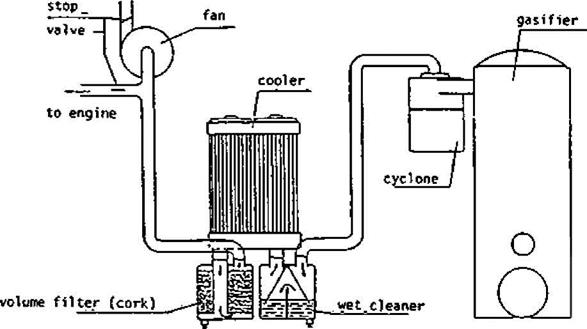 Fibre glass fabric filter system
Fibre glass fabric filter system
The gas cleaning for a typical wood gasifier system used in the Second World War was accomplished by a cyclone, a gas cooler with some scrubbing action and a packed bed filter, see Fig. 3.5a.
Systematic tests with this type of gas cleaning system have been reported by Nordstrom (33) according to which deposits were accumulated in the gas-air mixer and the inlet manifold at a rate of 1 — 2 g/h. The engine wear and the contamination of the lubrication oil exceeded considerably those observed on diesel fuel operation.
After considering several possibilities for improved gas cleaning systems such as fabric filters, electrostatic filters and wet scrubbers, fabric filters using a glassfibre cloth as filtering material were selected as most suitable for vehicle applications.
Figure 3.5 Gas cleaning systems for vehicles tested by Nordstrom (33) — a. Traditional
wet cleaning system
|
Figure 3.5 Gas cleaning systems for vehicles tested by Nordstrom (33) — b. Fabric filter cleaning system with cyclone. |
Glass-fibre cloth has a maximum operating temperature of about 300°C, which means that it is possible to operate the filter at a temperature giving a large margin over the dew-point of the gas. This is 45-60°C when wood with a moisture content of 20-35 percent is used as fuel. Operation of a fabric filter with condensation in the filter leads to a very high pressure drop across the filter and consequently a reduced power output of the engine.
To study engine wear and contamination of the lubricant oil comparative tests with wood gas operation using a fabric filter cleaning system, Fig. 3.5b, and diesel fuel operation were carried out with three farm tractors in field conditions. It was found, see Table 3.3, that the cylinder wear was considerably less than for the old type of cleaning system and in some cases even less than for operation on diesel fuel. A similar result was found for contamination of the lubricant oil. Dust concentrations after cleaning were 0.3 mg/m3 with the fabric filter system, as compared with 200 — 400 mg/m3 for the wet cleaning system. It can be
observed that Tiedema et al (42) consider that less than 50 mg/m3 is acceptable, and less than 5 mg/m3 is preferred.
After tests with different filter configurations, a standard filter box, see Fig. 3.6, was designed in which 8 filter bags giving a total filter surface of 3.0 m are placed. The box is insulated with 10 mm thick layer of mineral wool. The weight of a complete filter box is 65.5 kg.
It is recommended that the maximum gas flow through one filter box shall be less than about 65 m /h, giving an equivalent velocity through the filter fabric of 0.01 m/s at the operating temperature of 200°C.
The pressure loss over the filter depends on the load, and the amount of dust in the filter. If condensation occurs in the filter, and the fabric gets wet, the pressure loss will increase considerably.
For dry fabric with a normal dust layer, the pressure loss will vary with the load, approximately as in Table 3.4.
Practical tests with a truck (Scania Vabis L75, see Table 3.11), to study the increase of pressure loss with dust accumulation, show that for driving at 60 km/in on a flat road with clean filter bags, the pressure loss was about 150200 mm Wg up to 500 — 750 km (i. e. 8-12 h). The pressure loss then increased by 60 — 75 mm Wg per 1000 km. After 3000 km (i. e. 50 h) the pressure loss had increased to twice the value for clean filter bags.
|
Table 3.3 Experiences with different gas cleaning systems reported by Nordstrom (33)
|
The cleaning interval in practical operation is determined by how much power loss, resulting from pressure drop in filter, the driver is willing to accept. Normal cleaning intervals range between 1500 and 3000 km.
Measurements of pressure losses caused by condensation in the filter bags, see Nordstrom (33) show that the moisture may increase the pressure drop by a factor of over 6. In order to avoid condensation, the gasifier should be operated with the starting fan until the gas temperature at the outlet of the gasifier is about 250°C. This may require fan operation for 15 — 20 minutes, depending on-the ambient temperature.
|
Table 3.4 Pressure loss over fabric filter
1/ mm H20 measured with a water gauge |
